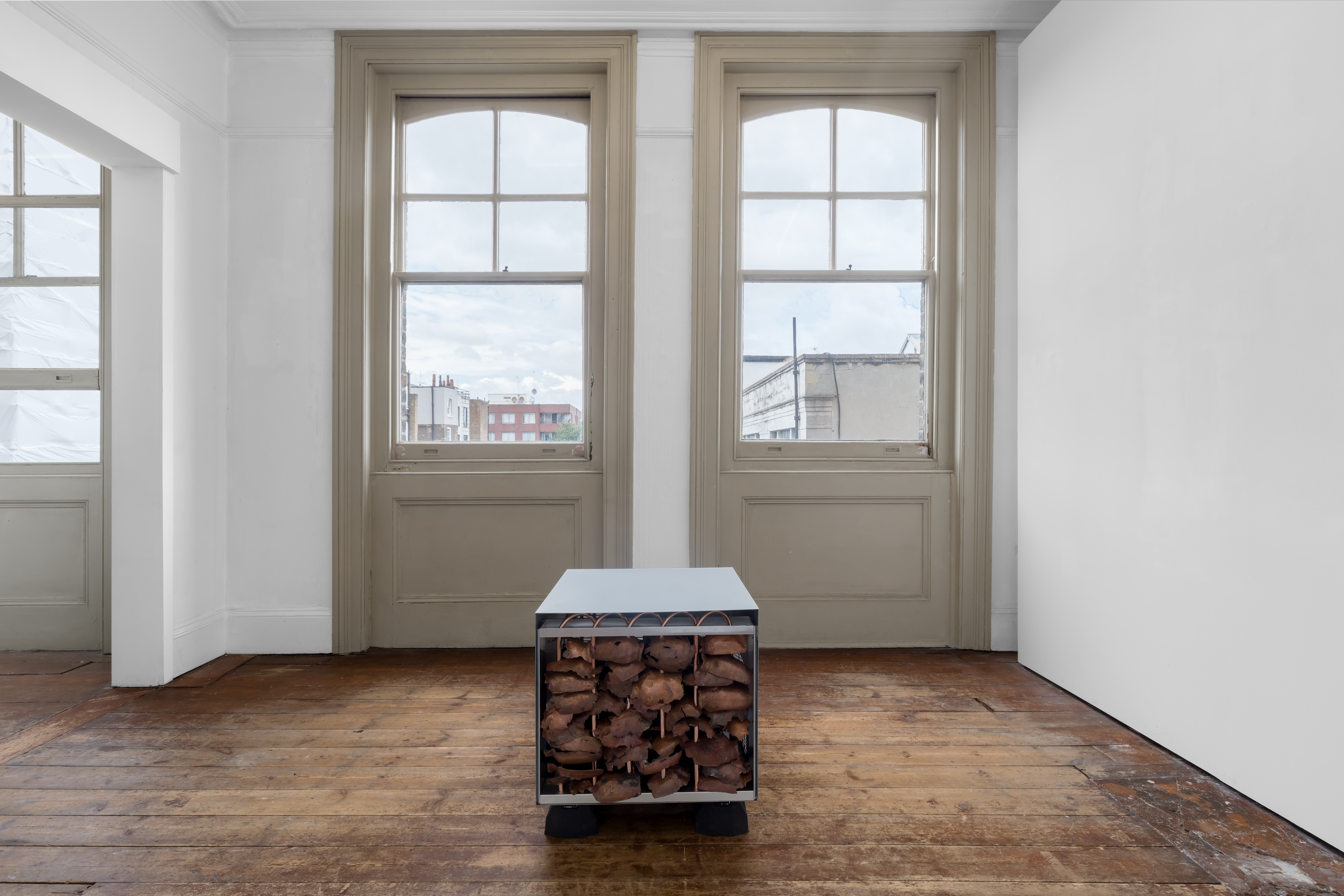


Brianna Leatherbury, Fudge, 2024, copper platings of a borrowed object, condenser, aluminium, copper and aluminium pipes. Courtesy: the artist and Brunette Coleman, London.
Brunette Coleman
42 Theobalds Rd, London WC1X 8NW
In the metaphysical scheme of things, a human’s lifespan represents a mere fraction of a millisecond relative to the omnipotent age of the universe. In this respect, the concept of preservation serves as an act of remembrance and legacy. Ontologically speaking, it permeates many aspects of life in subliminal ways. Self-preservation forms the crux of our day-to-day as one tends to habitually carry out rituals that reinforce and protect one’s own existence. Historically, this has manifested through survivalist tendencies and protectionist desires, from the act of burying food underground to keep cool, or the process of pickling for longevity, to the embalming of bodies interred in tombs, the material conservation of sacred objects and the protection of ancestral traditions passed down through oral histories, ancient folklore and storytelling. However, this sense of a biological finality is evolving, as scientific researchers contend with the notion that, at least statistically, the first person to reach 1000 years of age has already been born – supported by unyielding advancements in the multi-billion dollar cryogenic industry.
Brianna Leatherbury’s show ‘Survival Bias’ at Brunette Coleman takes the following question as its starting point: ‘which object would you take to your grave?’ To answer such an existential question, the artist enters into an exchange with individuals who have invested in the stock market, borrowing their chosen object and replicating it to be used as part of an artwork. For this show, Leatherbury selects the urn of a beloved pet cat named ‘Fudge’ from a London- based shareholder and parts of an ornate wardrobe – both are sentimental items re-imagined as remnants of commodity capitalism. They represent the affective ownership and attachment placed on wildly different entities which may well exist forever, given the right conditions. Leatherbury produces multiple copper renderings of these objects which are broken down and interspersed on and between quasi-industrial and corporeal structures in the gallery space, referencing heating and cooling units. Parasitic in their nature, these repeated fragments feel beholden to the structures they inhabit assimilating a kind of ecosystemic fungible growth.
Entering the main gallery, I am confronted by an imposing and bespoke walk-in ‘cold room’ that occupies half of the space whilst an incongruous hum reverberates from a hidden generator. Behind its heavy industrial steel door exists a curtain of harsh cold air that immediately pierces my chest. The cold emanates from a cooling unit inside the otherwise empty room and upon closer inspection contains fragments of Fudge’s urn, as if it were melding into the units’ vents and assimilating with the mechanical properties of the cooling system itself. The hum of the generator momentarily cuts out as the cold room reaches an optimal temperature that halts decay, and for a brief period, I can only hear the faint crackling sounds of coarse frost splitting and echoing throughout the system, in an otherwise deathly silent space.
Re-entering the warmth, I realise that the gallery is conversely heated by a second external unit attached to the cold room and interconnected to the cooling unit inside. I learn that the energy conducted from the copper inside this cooling unit is transmitting heat through the external vent and out into the gallery. This dichotomy of heating and cooling represents a moment of stasis as physical elements collide in amongst a system that strives for temperature-induced perfection, one half of the gallery seeks warmth whilst the other cold. In the middle of the floor a smaller white unit evokes the austere legacies of minimalism – at one angle a perfect white cube whose back end is hidden from site. Yet circuling the work exposes the vents which contain more interwoven copper urn fragments, alluding to the mutation and evolution of organic forms.
In the adjacent room are two wall sculptures which consist of precisely bent metal rods mimicking heating elements, interspliced with the rendered copper fragments of the wardrobe. Yet again, from a distance these fragments resemble organice forms such as strips of tree bark. On closer inspection what emerges is a motif of ornate carved flowers and a decorative sensibility transposed from the original design of the wardrobe.
The final works I encounter operate on a different plain altogether, the artist invites Ima-Abasi Okon (whose practice equally references the design and infrastructure of industrial systems as a way of questioning our relationship to labour and value) to produce a selection of wall-based texts in response to the show. These texts are appropriated, incomplete and non-linear excerpts of future writing by Taylor Le Melle who themselves writes on notions of property and value, cycles of healing and somatic therapy within artistic ecosystems. There exists a referential cycle at play between all three artists/writers and this mirrors the thermal processes that are in a constant state of flux and everlasting exchange throughout the gallery.
Leatherbury’s show probes deeply into the contested politics of cryogenics and the logic surrounding death in a market driven by preservation, legacy and remembrance. Skilfully harnessing the industrial blueprint of climate control systems, the artist tacitly produces an affective set of works that decouple mortality from time, ultimately highlighting the eternal qualities of ‘life’ and those who are prepared to pay for it.
Jordan Mouzouris, Curator, Digital
Brunette Coleman, 31 May – 6th July 2024